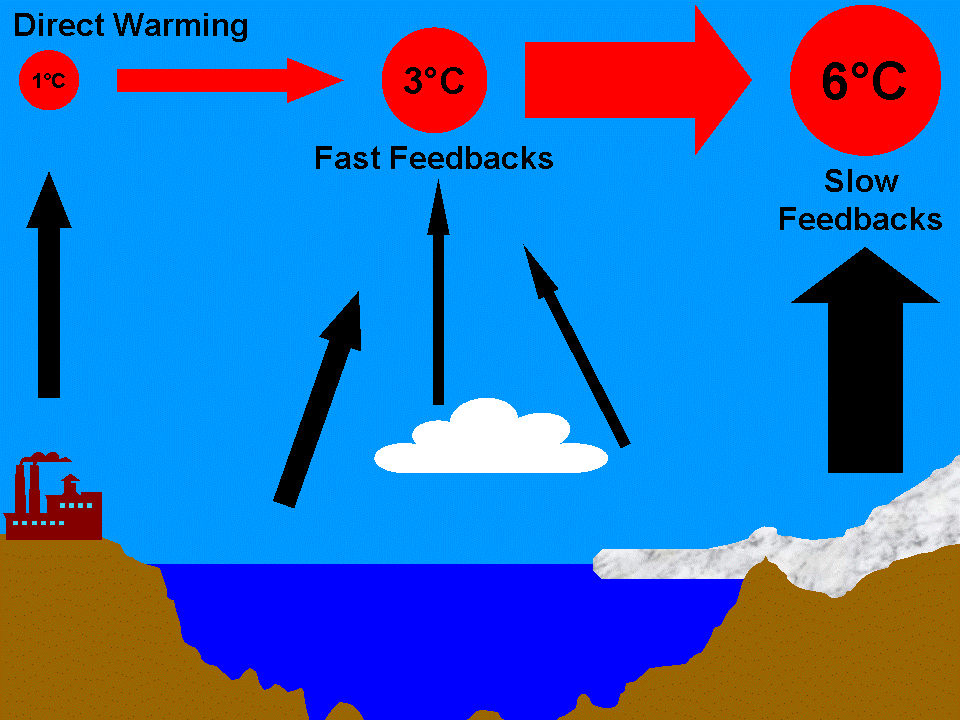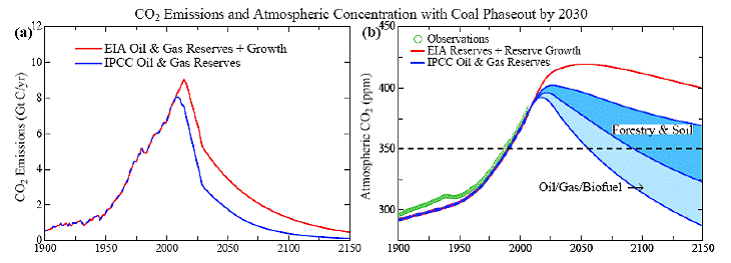
What The Science Says:
Global warming is an increasingly urgent problem. The urgency isn’t obvious because some warming is being delayed, and even more warming is yet to kick in. Some of the latest research says if we want to keep the Earth’s climate within its natural range during the time that humans have existed, we must leave nearly all of the remaining fossil fuels in the ground. If we do not act now we could push the climate beyond tipping points, where the situation spirals out of our control.
Climate Myth: It's not urgent
"There are many urgent priorities that need the attention of Congress, and it is not for me as an invited guest in your country to say what they are. Yet I can say this much: on any view, “global warming” is not one of them." (Christopher Monckton in testimony to the US Congress)
In 1992, 154 nations signed the UN Framework Convention on Climate Change, with the objective of preventing “dangerous anthropogenic interference with the climate system.” This raised the question: what exactly would constitute dangerous human interference? James Hansen, NASA’s top climatologist and one of the first to warn that greenhouse warming had been detected, was the lead author of a masterful 2008 paper which set out to answer that question. His team came to the startling conclusion that the current level of atmospheric carbon dioxide (CO2) is already in the danger zone.
Since the Industrial Revolution, atmospheric CO2 has increased from 280 to 390 parts per million (ppm). Don’t be fooled by the small number – in many countries, 390 ppm is over the legal limit for blood alcohol content while driving. More pertinently, it’s higher than CO2 has been in millions of years. CO2 is rising by 2 ppm per year as we continue to burn fossil fuels. Hansen and colleagues argue that to stabilise the Earth’s climate we must reduce CO2 to the relatively safe level of 350 ppm. And we must hurry, because the task will soon be an impossible one.
The 350 target is based not on climate modeling, but on how the climate has responded to past greenhouse gas changes in the real world. From a comprehensive look at past climate change (“paleoclimate”), Hansen concluded that, in the long term, climate is twice as sensitive in the real world as it is in the models used by the IPCC. This is the most complicated part, so bear with me for a few paragraphs.
The key problem in climate modeling is determining the value of “climate sensitivity”, or the amount of global warming you get from doubling CO2 once all climate feedbacks are taken into account. A feedback is something that amplifies or cancels out the initial effect (eg. interest is a feedback on a loan). The models include “fast feedbacks” like water vapor, clouds, and sea ice, but exclude longer-term “slow feedbacks” like ice sheets (ice is a feedback because an icy surface reflects more heat than a dark surface). There is a broad consensus that the fast-feedback climate sensitivity is 3°C. Though model estimates come with large error bars, paleoclimate-based estimates converge on the same number, 3°C.
Slow-feedback sensitivity has received far less attention. Paleoclimate is the only available tool to estimate it; Hansen used the highly accurate ice core record of the last few hundred thousand years. Further complicating matters, slow-feedback sensitivity is not stable over geologic time. The ice sheet feedback will only work if there is ice to melt, thus slow-feedback sensitivity is much higher when the planet has ice on it. To cut a long story short, it turns out the total climate sensitivity is as high as 6°C when there are ice sheets on the planet, as there are today. That is, the slow ice sheet feedback doubles the warming predicted by climate models.

So why the urgency? The global temperature has risen only about 0.7°C. The answer is the climate has not yet fully responded to our past emissions. We know this because the Earth is still gaining more heat than it is losing. There is further warming in the pipeline, and Hansen’s climate sensitivity implies there’s a lot more than in the models. If CO2 remains at or above 390 ppm long enough for the ice sheet feedback to kick in, the delayed warming would eventually reach 2°C (ie. 2.7°C above preindustrial times). That would result in an Earth unlike the one on which humans evolved and a sea level rise of not one metre, not two metres, but 25 metres. Imagine waves crashing over an eight-storey building.
It’s hard to dispute this would be “dangerous” climate change. But how quickly could it happen? In the past, ice sheets took millennia to respond, though once they got moving sea level could rise several metres per century. But maybe ice sheets can melt faster if CO2 rises faster, as it is now doing. The IPCC predicted they would grow by 2100, but instead they are starting to shrink “100 years ahead of schedule”. If ice sheets can melt significantly this century, then Hansen’s long-term warming has near-term policy implications. Once an ice sheet begins to collapse there is no way to stop it sliding into the ocean. We would be subjected to centuries of encroaching shorelines. The climate change we started would proceed out of our control.
Hansen confirmed his results using sediment core data, which allow a longer-term view, tens of millions of years. The Earth has been in an ice age since Antarctica froze 34 million years ago, around the time our distant ancestors split off from monkeys. The major cause of the descent into the current ice age was a natural decline in CO2 (related to continental drift and thousands of times slower than the current rise). According to Hansen’s calculations, the freezing point came when CO2 fell to 450 ppm. If we pass 450 ppm in the opposite direction, it will be the melting point. A return to an ice-free Earth would mean a sea level rise of 75 metres.
Finally, Hansen looked at the changes already unfolding. He concluded the current CO2 level also puts us at high risk of an ice-free Arctic Ocean in summer, desertification in Australia and equivalent latitudes, water shortages for hundreds of millions from glacier loss, and the devastation of coral reefs. But the tragedy we have set in motion can still be prevented, if we get the Earth to stop accumulating heat before slow feedbacks can kick in. To do so we cannot avoid targeting the greatest, fastest-growing, and longest-lived climate driver: CO2.
Under business as usual, we are heading for up to 1,000 ppm by 2100, or nearly two doublings (and that’s not even including possible greenhouse gas feedbacks). This would surely be an unimaginable catastrophe on any timescale. Even the mitigation scenarios governments are quarreling over are based on IPCC assessments now several years out of date. The lowest CO2 target being considered is 450 ppm. Unfortunately this is the same level which Hansen concluded would eventually melt all the ice on the planet.
Instead of stepping on or easing off the accelerator, we need to be slamming on the brakes. We must not only slow the rise of CO2 in the atmosphere, but reverse it. We must reduce CO2 from 390 to 350 ppm as soon as possible. That should stop the planet’s accumulation of heat. Stabilizing the CO2 level will require rapidly reducing CO2 emissions until nature can absorb carbon faster than we emit it – in practical terms, cutting emissions to near zero.
The only realistic way is to leave most of the remaining fossil fuels in the ground. Because CO2 stays in the atmosphere for a very long time, burning them at a slower rate makes little difference. Of the three conventional fossil fuels (coal, oil, and gas), coal has by far the largest reserves. It is not enough to slow down coal-burning by converting it to liquid fuels. The fundamental problem is with the coal being burned at all.
We also must not replace coal with other fossil fuels. We really don’t want to burn the tar sands and oil shale, whose reserves are virtually untapped but thought to contain even more carbon than coal. Unfortunately, the Canadian government is actively encouraging their burning; this cannot go on. What about conventional oil and gas? Energy experts disagree on how much is left. If it turns out we have already used about half of their reserves, then we can safely burn the rest (assuming we’re not burning any other fossil fuels). If the reserves are on the high side, we shouldn’t go to the effort of extracting the least accessible drops.
Supposing that we succeed in halting the rise of CO2, we will still be left with the gargantuan task of removing it from the atmosphere. Nature can absorb some carbon, but it has limits. We would also need to change our forestry and soil practices to absorb carbon rather than emit it.
It won’t be easy but it appears to be still possible to get back to 350 ppm, if we
1) phase out coal by 2030.
2) not burn the tar sands and oil shale.
3) not burn the last drops of oil and gas.
4) turn deforestation into reforestation.

With these actions CO2 could peak around 400 ppm as early as 2025 and return to 350 ppm by century’s end. I believe we can achieve this; it’s primarily a question of political will. But our window of opportunity is rapidly slamming shut. Even one more decade of business as usual, and CO2 can be expected to remain in the danger zone for a very long time.
For fear of being called alarmist, I should point out that estimating a CO2 target from paleoclimate is fraught with uncertainties. I’ve had to simplify somewhat for this short article. If you want to learn more, I explain Hansen’s methods and results in detail on Skeptical Science, or you can read the full paper for free here. But if there is one lesson recent climate research should teach us, it is that it’s a mistake to call uncertainty our friend. Arguably the most important aspect Hansen ignores, greenhouse gas feedbacks, is likely to make things even worse. There is more than enough reason for concern to heed Hansen’s warning.
Right now we stand at an intersection. What we do in this decade is crucial. If we choose one path, by the end of the decade the world could be well on its way to phasing out coal. If we choose the other, we face an uncertain future in which the only certainty is a continually shifting climate. I’ll leave the final word to Hansen et al, whose concluding statements were pretty strongly worded coming from a dense, technical, peer-reviewed, scientific paper:
Present policies, with continued construction of coal-fired power plants without CO2 capture, suggest that decision-makers do not appreciate the gravity of the situation. We must begin to move now toward the era beyond fossil fuels. Continued growth of greenhouse gas emissions, for just another decade, practically eliminates the possibility of near-term return of atmospheric composition beneath the tipping level for catastrophic effects.
The most difficult task, phase-out over the next 20-25 years of coal use that does not capture CO2, is Herculean, yet feasible when compared with the efforts that went into World War II. The stakes, for all life on the planet, surpass those of any previous crisis. The greatest danger is continued ignorance and denial, which could make tragic consequences unavoidable.
Intermediate rebuttal written by James Wight
Update August 2015:
Here is a related lecture-video from Denial101x - Making Sense of Climate Science Denial
 |
The Skeptical Science website by Skeptical Science is licensed under a Creative Commons Attribution 3.0 Unported License. |